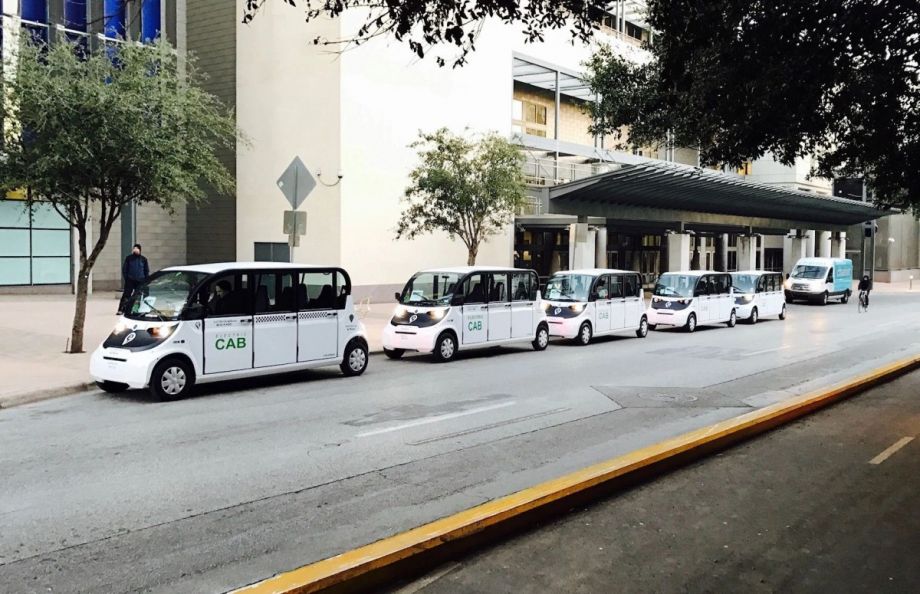Downtown STL, Inc, St. Louis’s downtown business association, wants to solve their neighborhood’s first-mile, last-mile transportation problems and bolster the economy in the process. To do so, they’re experimenting with on-demand transit, sometimes called microtransit. They’ve funded a four-month pilot project to serve downtown transit riders and drivers with free, on-demand shuttle rides.
From March 1 to June 30, a three-car fleet of electric cabs will operate in the roughly one-square mile downtown area. The five-passenger vehicles fall somewhere on the spectrum between a downtown circulator bus and UberPool and LyftLine, the ride-hailing services’ carpooling options. Customers will be able to order a ride with an app or by calling a phone number. The cabs will be able to pick up multiple passengers en route when they’re heading to and from similar locations. When the cabs don’t have passengers, they’ll drive fixed routes through high-use areas and people will be able to hail them, like a classic yellow cab. Downtown STL is funding the $135,000 pilot, which will be free for customers to use.
“This is about microtransit for the last mile,” says Downtown STL CEO Missy Kelley. “It supports both public transit and people who choose to use their cars.”
Kelley imagines people taking light rail to downtown, then calling up the shuttle to get from the light rail station to their office, or riding it mid-day to get to meetings around downtown. Similarly, for drivers, it would allow them to park once in a downtown garage and get around by cab during the day. Kelley hopes people will also use the service to go out to lunch more and spend money.
For the downtown association, the motivation is making it easier for people to navigate the neighborhood, thereby making it more attractive for visitors, workers and residents. Kelley says the downtown residential population has grown by about 7 percent each year since 2013. “We’ve got more people down here experiencing the urban lifestyle. We’re learning more about what the things are that enhance and support that lifestyle.”
Of course, Uber and Lyft already provide on-demand transportation in St. Louis. But Kelley thinks their free electric cabs will be more appealing for people whose trip is a little too far for walking, but maybe too short to justify paying for a ride-hailing service.
St. Louis is not the only city experimenting with microtransit and on-demand mobility. Most have had mixed success so far. Ford is currently operating its on-demand shuttle van company Chariot in six cities in the U.S. and England. Bridj, a startup that used 14-passenger vans to provide on-demand transit in Boston, Kansas City and Washington D.C., shut down last year after failing to get an infusion of funding. The company is relaunching in Sydney this year. A few years ago, Finland’s capital city Helsinki ran an on-demand transit pilot called Kutsuplus that cost passengers about three-quarters less than a typical cab ride. By the time the pilot ended on New Year’s Eve 2015, Kutsuplus was running 15 buses that required a 20 Euro-per trip subsidy.
Supporters said the subsidy could’ve been brought down to a reasonable level if the fleet was expanded. But Kutsuplus’s struggles illustrate the difficulty of private, on-demand transit—it’s very expensive and offering it at a price that’s competitive with other services likely requires a subsidy.
Accessibility advocates have frequently taken issue with private mobility services’ lack of ADA compliance. Last year, for example, the Department of Justice fined Chariot $50,000 for not complying to ADA standards. A Chariot spokesperson told Curbed that the company was supplementing some of the vehicles in its fleet with wheelchair accessible vehicles. The cabs in St. Louis’s pilot project can accommodate folding wheelchairs and walkers, but are not fully ADA accessible for motorized wheelchairs and other larger mobility devices. Kelley says they are looking into the possibility of accessible vehicles for the future of the program, but for now, wheelchair users have to rely on paratransit from Metro, the local transit agency.
Despite the cost and other potential shortcomings, some transit advocates see a place for on-demand mobility options in the transit landscape, especially when they can fill in gaps in fixed-route transit networks.
“The core idea is to save money on bus routes that are very expensive for an agency to operate [in low-density areas], but still provide comparable service on those routes. They can then use that extra funding to reinvest in other parts of system,” TransitCenter program analyst Zak Accuardi told Next City in 2016 after the transit research group released its report on transit agencies partnering with private mobility providers.
TransitCenter says another potential benefit of such partnerships is access to real-time data about user behavior that can help shape routes and service levels. Kelley says they’re planning to use data to dictate how many cabs are on the road at a given time and the routes they drive when they don’t have passengers.
Though the pilot is just getting started, Downtown STL is already looking beyond June. The end goal is to fold the service into Metro’s operations. When it does, it will likely switch from a free service to one with fare. “It would be a nominal fare,” says Kelley. “They’ll be short rides and we want to make sure it’s not cost prohibitive to anyone.”
To help offset the cost of operations, they’re considering running advertising on the side of vehicles and offering subscription services for large companies who want to make the cabs available to their employees.

Josh Cohen is Crosscut’s city reporter covering Seattle government, politics and the issues that shape life in the city.
Follow Josh .(JavaScript must be enabled to view this email address)


_600_350_80_s_c1.jpg)


_on_a_Sunday_600_350_80_s_c1.jpeg)










